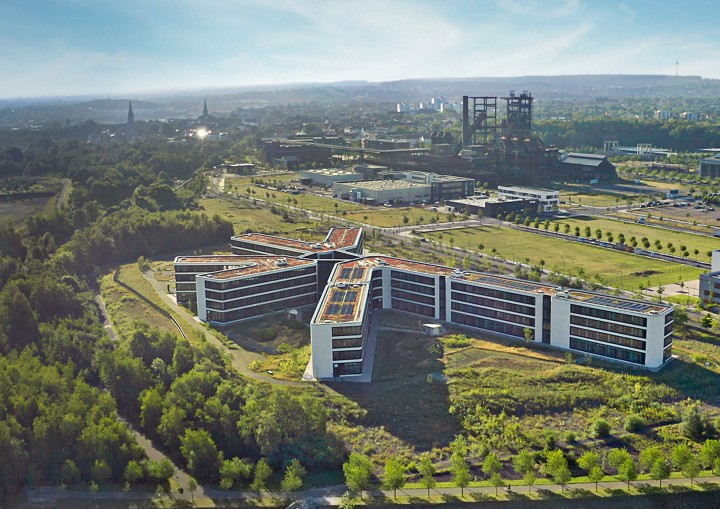Sustainability Management

Acting responsibly requires goal-oriented planning. This applies not only to the safe operation, expansion and upgrading of the grid but also to our commitment to people, the environment and society.
As part of its sustainability management, Amprion has developed a sustainability strategy that has clear objectives and comprises five fields of action. It also defines the framework for our regular Sustainability Report. In this report, we make our commitment visible and establish the basis for dialogue with our stakeholders. One focus here is on climate protection: based on our climate strategy, we have set ourselves ambitious objectives for reducing greenhouse gas emissions. Closely linked to this is sustainable financing of our investments.
Sustainability Strategy
Sustainability is an integral part of Amprion’s strategy and is being driven forward by the Management Board. Embodying and promoting responsibility, shaping the energy system of tomorrow – this is the objective we are pursuing with our sustainability strategy. We have identified 16 key sustainability issues, which we have assigned to five fields of action. These issues and the Sustainable Development Goals are anchored in the goals of our various departments. And we are working to implement them company-wide. For each field of action in our sustainability strategy we have formulated measurable key targets and sub-targets that we intend to achieve successively or have already achieved. We use the Sustainability Report to report on the progress we have made to date.
Climate Strategy
Amprion first developed a climate strategy in 2021 – and has been developing it continuously ever since. The establishment of climate targets was preceded by an analysis and quantification of past, present and expected future greenhouse gas emissions. The following reduction targets were set by Amprion on this basis:

Scope 1 and 2: We are aiming to reduce our direct and (energy-related) indirect greenhouse gas emissions (Scope 1 and 2) by at least 63 per cent by 2032 compared to the baseline year 2017.

Scope 3: We want to reduce the greenhouse gas intensity of our upstream activities (Scope 3) by 58.1 per cent by 2032 compared to the baseline year 2021 – referred to the length of routes expanded and renewed in Amprion’s transmission grid.
Our emission reduction targets are based on the assumption that our business will grow significantly in the coming years. They are in line with the requirements of the Science Based Targets initiative (SBTi). In this way, we want to align our business activities with the 1.5 °C target of the Paris Agreement on climate change. In mid-May 2023, Amprion officially submitted its targets to the SBTi for validation.
Stakeholder Dialogue
Amprion is operating in a truly diverse field of interest. That’s why maintaining a continuous dialogue with our stakeholders is so important. Stakeholder dialogue also plays a central role in Sustainability Management. For Amprion, dialogue with four specific groups is key: civil society and customers, politicians and authorities, our employees and the international capital market. This was revealed in an analysis carried out by the Sustainability Steering Committee in 2020.
In order to establish transparency and consistency in the dialogue with our stakeholders, we have defined clear responsibilities for communication with the respective stakeholder groups and laid down company-wide principles for dealing with them.
Sustainability Organization
Sustainability is anchored in fixed structures at Amprion. The Management Board bears responsibility for the company’s sustainable orientation. It defines strategic priorities and also adopted the Sustainability Strategy 2020.
Specialist departments are involved in Sustainability Management via the Sustainability Steering Committee, which is made up of senior executives from the Amprion departments concerned. The Steering Committee is coordinated by the Head of European Affairs and Sustainability Management, who is also a member of the committee and reports directly to the Management Board.

EU Taxonomy
Sustainability aspects are also becoming increasingly important in the context of financing and reporting. The EU Taxonomy – a classification system to identify environmentally sustainable economic activities – plays a central role here. By integrating renewable energies and expanding the grid as a condition of decarbonising the energy systems, we want to contribute to the EU’s environmental objectives from a climate protection perspective as well as through climate change mitigation and adaptation. We take care to minimise negative impacts on other goals here, especially biodiversity conservation.
Sustainability is additionally anchored in our financing strategy. Amprion plans to invest around 27.5 billion euros in restructuring the energy system until 2028. We are combining the long-term planning necessary to achieve this with solid, secure and – not least – sustainable financing. Amprion’s Green Finance Framework was developed in 2022 in this connection. It defines clear rules, for example on the appropriate use of funds from financial products such as Green Bonds or green promissory notes.
Contributions to the UN Sustainable Development Goals
Our sustainability programme simultaneously underlines our commitment to sustainable development. In 2020, therefore, we aligned our key issues with the United Nations’ 17 Sustainable Development Goals (SDGs) 2030. We reviewed how our business activities can contribute to achieving certain SDGs by boosting positive impacts and reducing adverse ones. To do this, we analysed all 169 sub-goals of the SDGs and concluded that we are in a position to influence five SDGs.